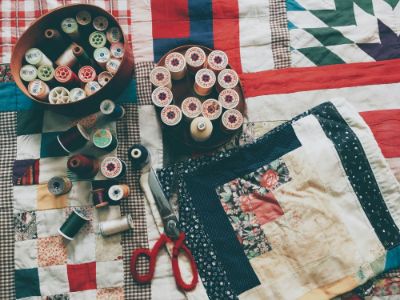Quilting 101: Getting Started on Your First Quilt
Quilting is one of those crafts that’s equal parts creativity, craft, and comfort. It combines fabric, stitching, and design to make something functional and beautiful — a blanket, a throw, a keepsake. If you’ve been thinking of trying quilting, here’s how to begin with confidence.
What Is Quilting?
In simple terms, a quilt is three layers:
Quilt top — the decorative, pieced or patchwork layer.
Batting — the middle layer for warmth or loft.
Backing — the fabric on the reverse side.
These are sewn (“quilted”) together, then the edges are finished (binding) to complete the quilt.
What You’ll Need: Essential Tools & Materials
Before you begin, gather some basic tools. You don’t need a full studio — just the essentials to get going. Here are some of the must-haves:
Fabric: Start with good quality cotton quilting fabric. Pre-cuts, like charm packs (5-inch squares) or strips, are great for first quilts.
Cutting tools: A rotary cutter, a self-healing cutting mat, and clear rulers. Accurate cutting makes a big difference.
Sewing machine & notions: A sewing machine (even basic) with a ¼-inch foot helps for piecing blocks. Also: thread, needles, pins, seam ripper.
Batting: You’ll choose type (cotton, polyester, wool etc.) depending on how warm, thick, or soft you want the finished quilt.
Iron and pressing tools: Pressing seams flat or open makes the pieces lie nicely and improves the look.
First Project: Keep It Simple
As a beginner, don’t overwhelm yourself. Pick a small project or an easy pattern so you can learn without frustration. Ideas include:
A baby quilt or crib quilt
A lap or throw quilt
A table runner
Start with few colour/fabric choices, simple block shapes (e.g. squares, strips), and an easy layout. Pre-cuts help simplify the fabric-cutting step.
Sewing, Piecing & Putting It Together
Cut carefully: Take your time to cut pieces accurately. A slight miscut can throw off the block.
Seam allowance: Consistently use a ¼-inch seam for piecing. Many patterns expect this.
Pressing: Press seams (either open or to one side). Nesting seams (where seams from adjacent rows are pressed in opposite directions) helps corners match neatly.
Basting the sandwich: Lay flat the backing, then batting, then quilt top, making sure layers are smooth and wrinkle-free. Use basting pins or spray adhesive.
Finishing Touches: Quilting & Binding
Quilting (stitching through all three layers): Straight‐line quilting (e.g. quilting “in the ditch” along seams) is simpler to start with. Free-motion quilting comes later.
Binding: The final edge. You can buy premade binding or make your own. It neatly encases the raw edges and gives your quilt a polished finish. (Singer)
Common Mistakes & Tips From Experience
Here are things new quilters often trip over, and how to avoid them:
Don’t cut backing and batting exactly the same size as the top: leave extra so you can trim after quilting.
Don’t try something super ambitious at first; large quilts are harder to manage.
Use enough basting, so that the three layers don’t shift when quilting.
Be mindful of stitch length: too small makes quilt stiff and can lead to lots of stitches per inch which may not show.
Enjoy the Process
Quilting is as much about the journey as the finished product. Take your time, allow for mistakes (they teach a lot), and celebrate each step. The more you do, the better you’ll understand fabrics, designs, and what kinds of quilts you most enjoy.
If you want, I can pull together a list of beginner-friendly quilt patterns (free ones) and NZ sources for fabric & batting. Do you want that?

